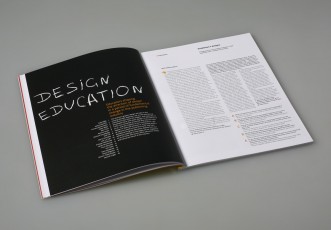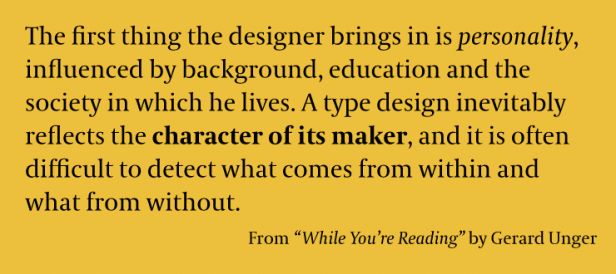Design Education, Part IV: Gerard Unger
Well-known international design instructors answer our poll about job opportunities for design graduates, the differences between academic theory and real-world practice, specialisation vs general education, and their own motivations to teach design. (This is the full version of the poll published in TYPO 43.)
Design Education
Educators shaping the direction of design in a period of fundamental change in the publishing industry
Palo Bálik, Marcel Benčík, Tomasz Bierkowski, Peter Biľak, Min Choi, Patrick Doan, Richard Doubleday, Will Hill, Gerry Leonidas, Loîc Le Gall, Kristjan Mändmaa, Jacek Mrowczyk, Titus Nemeth, Ivar Sakk, Ewa Satalecka, Silvia Sfligiotti, Martin Tiefenthaler, Gerard Unger
The direction graphic design will take in the coming decades depends a lot on the educational institutions that teach the subject, and especially on the people there who teach design. As the editors of TYPO, we constantly encounter this issue as most of us—and the majority of our contributors—are regular or featured lecturers or workshop leaders at various schools around the world. We have decided to bring the education debate from our editorial meetings to the pages of our magazine so as to foster discussion about education today, and hence the future of the industry.

Gerard Unger, Rietveld Academy, Leiden University, University of Reading
What motivated you to decide to teach design and/or typography?
The great thing about teaching is that you learn so much yourself.
Can you estimate about how many graphic designers your country graduates each year? Are there job opportunities in their field?
In the Netherlands it must be something like 40 to 50 graduates each year. Many end up in different lines of work – which is also the case for lawyers, for example.
Coranto 2 by Gerard Ungerd. Published by TypeTogether
Does your school find that there is a certain gap between “the real world” and what students learn at school? If so, how do you deal with this issue?
No matter how hard you try to close this gap, it will always be there. A school is a very protective environment. When I graduated 44 years ago, I had to adapt to the real world as well – three weeks to design a poster in school, three hours in the advertising agency.
Should schools provide a universal education in graphic design, or is it important these days to specialise in specific areas and tasks?
I think a universal education is much more useful than specialization. In the real world, specializations are learned quickly.
Do you think it is a good idea for students to work on actual commercial contracts while they are still in school? Should the school and the instructors at the school support this?
I think a practical year or half year is a good supplement to an education. An outright commercial contract is something else.
| When I first taught, I was merely giving it a shot, I didn’t know what to expect. Soon enough, however, I discovered that teaching did appeal to me for a number of reasons. Discovering in practice what it meant to articulate one’s thoughts, processes and routines to a student was probably the most rewarding experience. The reflection and learning that has to go into teaching is what retains the biggest challenge and interest. The more obvious motivation of passing on knowledge and “savoir-faire” is particularly pertinent in my teaching in Morocco, where my interests, work and skills are most immediately applicable. |
Add Comment
Author’s latest articles
- By Design conference in Bratislava 11. 5. 2014
- Live from Typo Berlin 15. 5. 2013
- Download Typo for your iPad! 4. 12. 2012
- Design From Best 2012 18. 6. 2012
- Slanted issue # 17 – Cartoon / Comic 30. 4. 2012




 editors
editors

Comments (0)